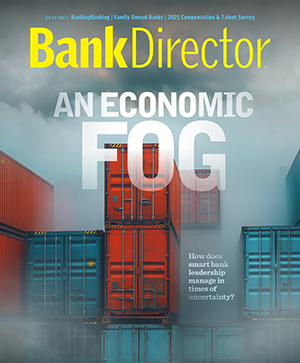
For Your Review
Lending Lessons from the Past
Comptroller of the Currency John C. Dugan has said that, with problem loans rising, itu00e2u20acu2122s imperative that bank management identify and address problems realistically and that the OCC deal with national banks in a consistent and balanced way.
The OCC has spent a good deal of time evaluating what went wrong during the late 1980s and early 1990s, and the lessons learned from that periodu00e2u20ac”including a recognition of mistakes made by the OCC will help the agency deal with problems in the current environment, Dugan said in a recent speech.
In the last real estate downturn, he said, OCC examiners tended to make unilateral adjustments to real estate appraisals that had become outdated due to clear changes in the markets. Today, he said, the OCCu00e2u20acu2122s preference is to direct management to obtain a new appraisal, and then give the bank a reasonable amount of time to review that appraisal and use it to make decisions about how to classify loans.
The comptroller also noted that the OCC did not give enough credit in the last downturn to bank managements that were dealing realistically with problems.
u00e2u20acu0153When we see that bank management is realistically recognizing losses and taking tough steps to deal with problems, we are going to give the bank more latitude than we will when we find a management team in denial that forces us to do their work for them,u00e2u20ac the comptroller said.
Comptroller Dugan stressed the importance of effective, two-way communication and said that was an area in which both the OCC and the banks it supervises fell short in the earlier period.
u00e2u20acu0153We aim not to repeat that mistake,u00e2u20ac he said. u00e2u20acu0153Our regulatory expectations must be clearly articulated, consistently applied, and effectively enforced.u00e2u20ac
Banks also need to be forthright. u00e2u20acu0153There is a natural tendency for banks experiencing difficulties to regard examiners with trepidation and to say as little as possible,u00e2u20ac Dugan said. u00e2u20acu0153I would encourage banks in these circumstances to take exactly the opposite approachu00e2u20ac”to engage their examiners even more than they might have in good times. Why? Because when problems arise, our examiners need more information, not less, to understand the true dimensions of the banku00e2u20acu2122s problemsu00e2u20ac”rather than assuming the worst.u00e2u20ac
The comptroller pointed to commercial real estate loans, which played an outsized role in the banking downturn of the late 1980s and early 1990s, and said too many community banks today are having too hard a time coming to grips with problems in these portfolios.
u00e2u20acu0153These bankers are reluctant to charge off obviously troubled loans or even to flag problems to their examiners,u00e2u20ac he said. u00e2u20acu0153While this resistance to recognizing problems at the beginning of an economic downturn may be human nature, itu00e2u20acu2122s not healthy, because denial is not a strategy.u00e2u20ac
The comptroller underscored that the OCC plans to work with community banks to address problems as they arise.
u00e2u20acu0153That process works best with a combination of early and realistic problem identification by bank management, frequent and robust communication between bankers and examiners, and balanced supervision,u00e2u20ac the comptroller said. u00e2u20acu0153If we do all that, weu00e2u20acu2122ll go a long way towards achieving our common goal: to make sure that banks remain safe and sound, and continue to meet the credit needs of a growing and prosperous America.u00e2u20ac
Total Bank Insurance Revenue Up Slightly in 2007
The nationu00e2u20acu2122s bank holding companies experienced a slight increase of 0.5% in their total insurance revenue, from $43.5 billion in 2006 to $43.7 billion in 2007. Citigroup, Wells Fargo & Co., HSBC North America Holdings, BB&T Corp., and Bank of America Corp. led all bank holding companies BHCs with significant banking activities in total insurance fee income in 2007, according to recently released findings by the American Bankers Insurance Association and Michael White Associates (MWA).
The findings are based on data reported to the Federal Reserve Board by top-tier BHCs. The analysis measures the banking industryu00e2u20acu2122s insurance business and provides some benchmarks that gauge bank insurance performance.
u00e2u20acu0153Among the top 50 in insurance revenue, the mean ratio of insurance revenue to noninterest income was 13.4% in 2007,u00e2u20ac said Michael D. White, president of MWA. u00e2u20acu0153For those BHCs engaged in them, insurance activities continue to make meaningful contributions to banking net-operating revenues.u00e2u20ac
During 2007, 637 bank holding companies (or 68.1% of all top-level BHCs reporting) earned some type of insurance-related revenue, compared to 642 in 2006. BHC insurance brokerage fee income increased 1.0% from $12.13 billion in 2006 to a record $12.26 billion in 2007, as 632 bank holding companies (or 67.5% of all top-level BHCs reporting) engaged in sales activities that produced insurance brokerage fee income.
u00e2u20acu0153Insurance brokerage fee income had been racing upward at a compound annual growth rate of 19.5% from 2001 through 2006,u00e2u20ac said Valerie Barton, executive director of the American Bankers Insurance Association. u00e2u20acu0153It flattened out in 2007 due to softening property/casualty premiums, changes in bank charters to thrifts that do not report insurance brokerage income, and a few sales of large property/casualty agencies by banks whose particular circumstances, strategic aims, and commitment to insurance had changed. Insurance brokerage remains healthy, and the prospects for a resumption of growth in bank insurance revenues are very positive.u00e2u20ac
The analysis includes a ranking of the top 50 bank holding companies on the basis of the absolute dollar amount of total insurance revenue (earnings from sales and underwriting) and on the basis of total insurance revenue as a percentage of the institutionu00e2u20acu2122s total noninterest income.
Forum Created for
Independent Chairmen
The Millstein Center for Corporate Governance and Performance at the Yale School of Management recently announced the formation of a first-ever peer organization of independent chairmen of North American corporate boards. The kickoff roundtable for the u00e2u20acu0153Chairmenu00e2u20acu2122s Forumu00e2u20ac will take place Oct. 7 at the Yale Club of New York City. The Millstein Center will serve as secretariat to the forum.
Harry Pearce, chairman of Nortel Networks, is the founding chair of the forum. The project is cosponsored by Spencer Stuart, the global director and executive search consulting firm. The October event is expected to draw independent leaders from large U.S. and Canadian corporations. The forum is intended for independent chairmen to share peer experiences; test opportunities for collective action on market issues; and form the core of a global network of chairmen organizations.
Advocates contend that an independent chairmanu00e2u20acu2122s can strengthen a boardu00e2u20acu2122s leadership in overseeing a companyu00e2u20acu2122s CEO and management, and can open a conduit for dialogue with investors. So far, an estimated 35% of S&P 500 corporations have moved to install a separate chairman rather than combining the job with that of the CEO. Some 13% are independent nonexecutives, according to Spencer Stuart. However, the Millstein Center projects a significant medium-term upward trend in the number of companies taking this option. Separate chairs have become commonplace in most other markets. Recently, high-profile boards of U.S. companies such as Washington Mutual and Citigroup have chosen to divide the chairman and CEO jobs between two individuals. Canadian boards, responding to shareholder requests, have begun converting to independent chairmen. And shareholders at ExxonMobil last week, for the second year in a row, produced a strong vote in favor of moving that company to the independent chair model.
Pearce intends for the inaugural Chairmenu00e2u20acu2122s Forum to consider endorsing policy guidance on the role of an independent chair in a North American context. The Millstein Center is drafting the statement with oversight from Pearce and Ira M. Millstein, senior associate dean for corporate governance at the Yale School of Management (and the centeru00e2u20acu2122s namesake) and senior partner at Weil, Gotshal & Manges.
u00e2u20acu0153The Chairmenu00e2u20acu2122s Forum will help anchor the model of independent board leadership in real-time experience and performance,u00e2u20ac said Pearce. u00e2u20acu0153The time is right for the growing number of those actually doing the job to build knowledge on how independent leadership can best work.u00e2u20ac
u00e2u20acu0153Board directors will benefit from seeing exchanges amongst real world independent chairs who contribute to performance while avoiding pitfalls,u00e2u20ac said Millstein. u00e2u20acu0153Independent chairmanship may not be the right way to go for every company. But the Chairmenu00e2u20acu2122s Forum will help make it a successful choice for those that take that route.u00e2u20ac
More Legal Work Will Go In-House
The 2008 Chief Legal Officer Survey, conducted annually by Altman Weil Inc., reports an upcoming shift in the inside-outside mix, with chief legal officers (CLOs) planning to increase law department staffing and decrease outside counsel usage in the next 12 months.
Forty-nine percent of chief legal officers participating in the survey plan to extend their in-house capabilities by hiring additional lawyers in the next year, jumping from 40% last year.
In addition, 26% of law departments plan to decrease their use of outside counselu00e2u20ac”up significantly from 16% in last yearu00e2u20acu2122s survey. Only 8% of CLOs plan to increase their use of outside counsel, down from 18%.
u00e2u20acu0153Itu00e2u20acu2122s interesting that in this economy, with many CEOs reportedly planning layoffs, chief legal officers are planning to hire more lawyers,u00e2u20ac notes Altman Weil principal Daniel J. DiLucchio. u00e2u20acu0153This reflects the pressure law departments are under to control costs and to do more work in-house where they are paying u00e2u20acu02dcwholesaleu00e2u20acu2122 instead of u00e2u20acu02dcretailu00e2u20acu2122 for legal services.u00e2u20ac
Chief legal officers identified cost control as their top concern over the next three to five years according to the survey. Cost control was rated first by 28% of CLOs responding, a two to one margin over the next issue of u00e2u20acu02dclimited resourcesu00e2u20acu2122 chosen by 14% of respondents. Compliance, which was the top concern for CLOs in each Chief Legal Officer Survey from 2003 to 2007, fell to number three in the 2008 survey.
This year for the first time, the Chief Legal Officer Survey looked at outside counsel use by law firm size. Survey respondents indicated that, on average, 20% of their legal work went to megafirms with over 750 lawyers; 25% of work went to large firms (350-750 lawyers); 27% of work was done by medium-sized firms (100-349 lawyers); and, 35% of work went to small firms with under 100 lawyers.
However, when asked how that same work was allocated based on the dollar value of the business, CLOs surveyed indicated that 37% of their outside counsel expenditures went to megafirms, 26% to large firms, 23% to mid-sized firms and 22% to small firms.
u00e2u20acu0153The fact that megafirms handle 20% of matters but collect 37% of fees is not surprising because corporations are likely to put u00e2u20acu02dcbet-the-businessu00e2u20acu2122 matters that are not price-sensitive into the hands of those firms,u00e2u20ac explains DiLucchio. u00e2u20acu0153This is important because it means that a CLOu00e2u20acu2122s ability to negotiate fees and control costs is really limited to less than two thirds of a law departmentu00e2u20acu2122s outsourced work.u00e2u20ac
When asked if they have fired or are considering firing at least one of their outside law firms this year, 48% of CLOs answered affirmatively, compared to 32% in the 2007 survey. The reasons for their dissatisfaction with outside counsel were: u00e2u20acu02dcmishandling a critical matteru00e2u20acu2122u00e2u20ac”named most often, followed by u00e2u20acu02dcpoor quality legal work,u00e2u20acu2122 and u00e2u20acu02dccost management issues.u00e2u20acu2122
Although outside counsel have taken steps to improve working relationships with their clients, not all efforts are perceived as equally valuable. In ranking relationship building efforts, chief legal officers named u00e2u20acu02dcdiscounted feesu00e2u20acu2122 number one, as well as u00e2u20acu02dcimproved responsiveness,u00e2u20acu2122 u00e2u20acu02dcimproved project staffingu00e2u20acu2122 and u00e2u20acu02dclearning our businessu00e2u20acu2122 as the most important efforts law firms can make.

Join OUr Community
Bank Director’s annual Bank Services Membership Program combines Bank Director’s extensive online library of director training materials, conferences, our quarterly publication, and access to FinXTech Connect.
Become a Member
Our commitment to those leaders who believe a strong board makes a strong bank never wavers.

